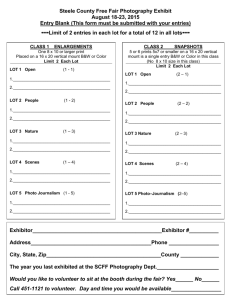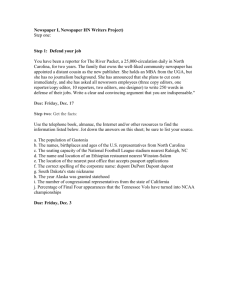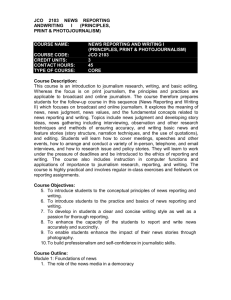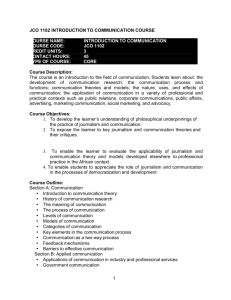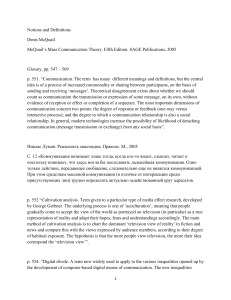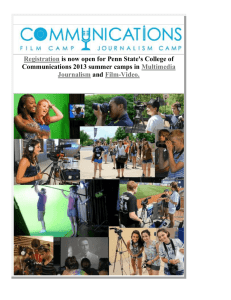School of Journalism & Mass Communication
advertisement
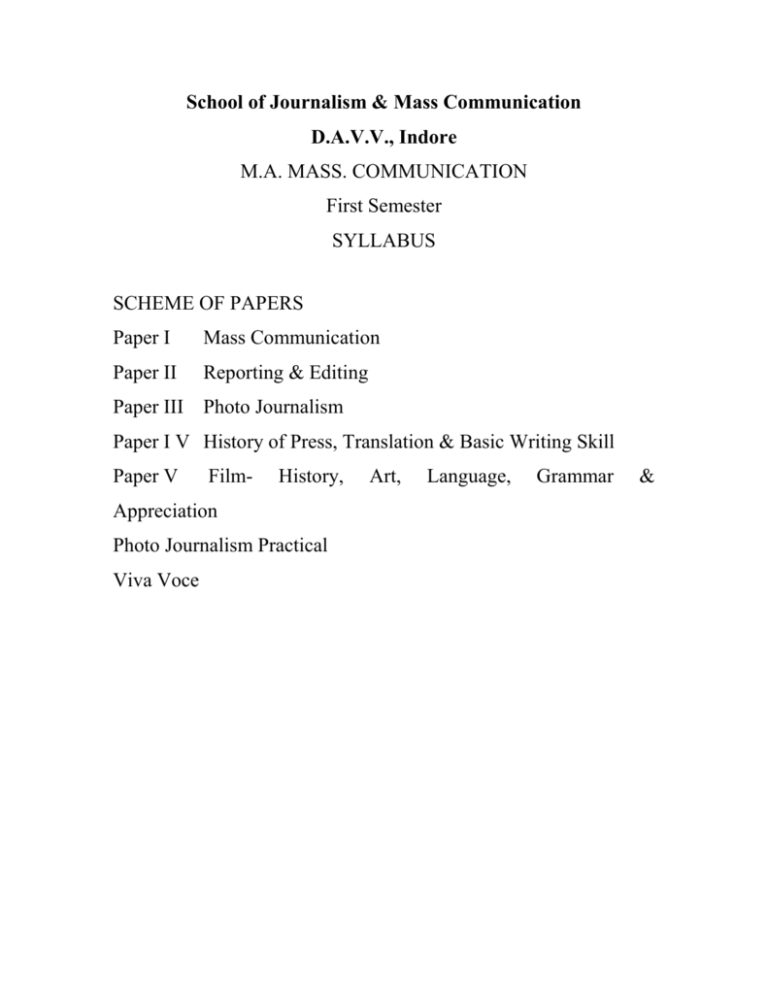
School of Journalism & Mass Communication
D.A.V.V., Indore
M.A. MASS. COMMUNICATION
First Semester
SYLLABUS
SCHEME OF PAPERS
Paper I
Mass Communication
Paper II
Reporting & Editing
Paper III Photo Journalism
Paper I V History of Press, Translation & Basic Writing Skill
Paper V
Film-
History,
Appreciation
Photo Journalism Practical
Viva Voce
Art,
Language,
Grammar
&
PAPER—I
MASS COMMUNICATION
UNIT-1
Forms of Communication- Intra personal Communication, Inter Personal
Communication, Small Group Communication,
Public Communication, Mass
Communication, Non Verbal Communication, Verbal Communication.
UNIT-2
Models of Communication
Arisotal model
SMRC model
LASWELL model
Shanen & Weawer model
Osgood & Schrrame model
Gerbner model
Gate Keeping model
Newcomb model
UNIT- 3
Theories of communication
Impact of mass communication, Limitations of mass communication
Demystification, Decentralization, Future Trends in mass communication
UNIT-4
Barriers to communication
Concept of selective perception, exposure, retention.
UNIT-5
• Brief study of communication technologies.
Post and Telegram, telegraph, Telephone, Cellular, Pager, Radio, Computer,
Fax, E. Mail, Internet, mobile.
READING LIST
1.Understanding Mass Communication- De Fleur
2.A Dictionary of Communication & Media Studies- Bittner John
3. Mass Communication in India- Keval j Kumar
4. Mass Communication-Wilbur Schramm
5. Mass Communication Theory & Practice-Narula Uma
6. Communication- S.S. Chabra
7. Understanding media-Marshall mcluhan
8.lapkj ek/;eksa dk izHkko&MkW- vkseizdk’k flag
9-laisz"k.k&MkW- Jhdkar flag
10-tulapkj lexz& MkW- vtqZu frokjh
11-tulapkj vkSj fgUnh Ik=dkfjrk& MkW- vtqZu frokjh
PAPER II
REPORTING & EDITING
UNIT-I
Journalism: Concept, Types- Citizen Journalism, Embedded Journalism, String
Journalism, Tingo Journalism.
Structure of a news report.
Intro: Types & Structure
UNIT- 2
Concept and kinds of beat: in depth reporting sports. Crime, accidents & disasters
legislature. Courts, follow-up story
Categories of reporter: City, special correspondent, Foreign correspondent,
stringer, function & responsibilities,.
UNIT-3
Headlines : Functions and types, Headlining TP news story. Reporters news story
or interview, correspondent news story. Editing of an article, a feature. Intro
purpose & types, ideal conventional quotation, question etc.
Interview : Definition, Types, preparation and do’s & don’ts, Press conferences.
UNIT- 4
Editing Principles of’ editing elements of Editing, precautionary measures and
golden rules.
Structure and Origination of an editorial department. Role of news editor, deputy
news editor, chief’ sub-editor. Qualities of a good sub-editor, Editing Online
UNIT-5
News Agencies: Indian and Foreign news agencies
READING LIST
1.Professional Journalism-M.V.Kamath
2. The Complete Reporter3.Practice of Journalism (A guide to reporting and writing the News)
4.Reporting & Editing (k.m.srivastav)
5.Modern newspaper(F.W.Hodgson)
6.Editing (Thomas R.Berner)
7.Editing(George T.J.S.)
8.Lkekpkj laiknu&izseukFk prqosZnh
9-laiknu dyk&MkW- gfjeksgu
10-laiknu dyk&MkW- vtqZu frokjh
11-Ik=dkfjrk ds fofo/k vk;ke&MkW- osnizrki oSfnd
12-laiknu dyk&dey nhf{kr
13-laiknu dyk&,u-lh- iar
PAPER III
PHOTO JOURNALISM
Unit 1
1. Photo Journalism its Role & Importance
2. Meaning, Definition of Photography & History of photography
3. Tools of photography
4. Types of Camera (Traditional & Digital)
5. Parts of Camera (Lens, Aperture, Shutter speed, Film).
6. Camera Control & Creativity.
7. About Digital Photography
8. Automatic all the Way
9. Working of Digital Camera & Comparison
10. Selecting Image Size & Quality & File Format
11. Practicals
Unit 2
1. Lighting (Role of Lighting, Different types of lighting & it’s uses)
2. Role of subject
3. Quality of Photographs (Types of Paper)
4. Role of Visulization
5. Shots
6. How to take a good picture
7. Practicals
Unit 3
1. Development of Photographs (Printing Process- Black & White, Lab
Printing, Thermal, Inkjet)
2. Editing & Croping
3. Composition of Photography
4. Filters
5. Practicals
Unit 4
1. Branches of Photography
A. Photographing People : Photography Aestietics of people (Male,
Females, Couples, Groups & Child Photography) in Studio &
Outdoor & Avaliable light.
B. Product Photography : Using selective Focus, Exposure Affects your
Images, Controling Brightness & Contrast
C. Interior & Exteriors : Architectural Photography, Industrial
Shooting(Internal & External) Use of various wide range Lenses,
Lendscape Photography; Scienceshots.
D. Action & Sports Photography : To Capture the action in different
ways to know the game first , Selecting the game first, Selecting the
Equipment According to the game (Use of various Zoom & Tele
Lenses & Tripods)
E. The PhotoShoot from Start to Finish : Photography of the given
theme to selecting subject to select the equipment the location &
Final Shooting.
2. Final Finish Before printing , work on softwares (Photoshop)
Unit 5
1. Use of Printer, Scanner, PAN Drive(Media), CD & DVD Burning
2. Special Effects (Panning, Zooming etc)
3. Practicals i(Outdoor, Indoor)
READING LIST
1. An Introduction to Photo Journalism- (Hicks & Wilson
2. Photo Journalism- The Visual Approach (Hoy. Frank P.)
3. News paper Photography, A Professional view of Photo
Journalism. Today, (John Alun)
4. The History of Photography (Newhall.B.)
5. Photography & The La (Durernet. Christopher).
6. Successful Freelance Photo Journalism (Mcintosh. I)
7. Book Ref. Tom Ang : Digital Photography an Introduction
Publisher’s Name: Dorling Kindersiey Ltd.
8.QksVsk Ik=dkfjrk&xqykc dksBkjh
PAPER IV
HISTORY OF PRESS, TRANSLATION & BASIC WRITING SKILL
UNIT- I
• Early beginning of Journalism: Pre printing period Verbal Journalism
hand written news sheets.
• A Brief History of printing & Typography
• The Birth of Journalism in India : Early Anglo— Indian News papers Hicckys
Gazette.
Unit II
• Birth of Language journalism Development of Bengali and hindi newspapers.
• Social reform movement and journalism
• History of Hindi journalism.
UNIT- 3
• Role of the Press during the freedom struggle.
• Significant Developments in the growth of Journalism in Madhya Pradesh.
• Prominent personalities of the Indian Journalism.
• The Press in India after 1947, Current trends in English and language journalism
in India.
UNIT- 4
Hindi Journalism during 1990-2008
Pioneers of Journalism Trends
Characteristics of Important Indian newspapers
UNIT- 5
Concept of Translation. • Fundamental principles of translation; difference
between translation. •Translation of the following kinds of editorial matter, news
story, features, articles, letter to editor.
• Language and meaning : Difference between spoken and written.
• Language function . Expressive informative, Vocative.
• Qualities of good writing Clarity, brevity, flow, readability, Sentence and
paragraph. Structure Beginning, development, focusing and conclusion.
• Diversity and uniformity of Media language, style book.
Reading List
1. Role of Press in the Freedom Movement. (Motilal Bhargav)
2.Journalism in India. (RangaSwamy ParthSarthi)
3.History of Journalism in India (J. Natrajan)
4.Battle for Freedom of the Press in India.(K..S.Padhy)
5.Translation through Media in New Millennium (K.K.Rathi)
6.Good Writing An Informal Manual of Style (vrooman Alnh.)
7.Improve your Writing.(Arora & Chandra)
8.fgUnh Ik=dkfjrk dk o`gn bfrgkl % MkW- vtqZu frokjh
9-Hkkjrh; Lora=rk vkSj fgUnh Ik=dkfjrk% ca’kh/kj yky
10-fgUnh Ik=dkfjrk bfrgkl o iz’u% d`".kfcgkjh feJ
11-fgUnh Ik=dkfjrk ds dhfrZeku % txnh’k izlkn
12-Ik=dkfjrk dk bfrgkl% ,u-lh- iar
13-vuqokn dyk fl)kar o iz;ksx% dSyk’kpUnz HkkfV;k
14-Ik=dkfjrk esa vuqokn% ftrsUnz xqIrk
15-vuqokn ds fofo/k vk;ke% iqjupanz VaMu
16-e/;izns’k esa fgUnh Ik=dkfjrk% dSyk’k ukjn
19-fgUnh Ik=dkfjrk fofo/k vk;ke% MkW osnizrki oSfnd
20-Modern Journalism & Mass Communication (Dr. Baldev Raj Gupta)
21. Modern Journalism issues & Challenges (Swati Chouhan)
22. fgUnh Ik=dkfjrk fodkl vkSj fofo/k vk;ke% “kSys”k tks”kh
PAPER V
FILM HISTORY, ART, LANGUAGE - GRAMMAR & APPRECIATE
UNIT-I
The birth of cinema
Film & Modern men
Lumier brother’s package
The Grand father of Indian cinema: Dada Saheb Phalke
The silent era (1896-1930)
The talkie era and decade wise trend up to 1931-1950
Prabhat Film Company
New Theaters
Bombay Talkies
UNIT –2
Film as an art Film and painting Film and theatre Film and literature
Film and music Film language and grammar
(A)Shot, scene & cut,
(B)Camera Distance,
(C) Camera Angles,
(D)Camera movements
(E) Lighting
(F) Sound in films
(G) Film Editing devices
UNIT-3
Economics of Indian cinema
Department of Film making & Persons.
Film Production, Distribution & Exhibition.
Film Publicity: Press, Radio, Satellite Channels.
Multiplex Corporate Culture.
NRI, NITCH, Cross over, Pop Corn cinemas.
UNIT-4
Film institutions in India
Film festivals (National and International)
Film awards
Film censorships
Enrichment of human life a social-cultural values through films.
Future of films.
UNIT-5
Case studies of contemporary films
Audience Research & Servey
Detail review & analysis of current films as a projects.
Reading list
1.Indian Film. (OUP Second Edition.)
2.How Films arc made (National Book Trust.)
3.Film as an art and film appreciation (NCERT. New Delhi)
4.Cinematography Censorship Rules Govt. of India Pre Nasik.
5.Cultural Heritage of India.(Basham.A.L.)
6.Hindi cinema ka itihas (Manmohan Chaddha)
7.Indian Films (Krishna Swamy, Eric Bourno)
8.Frames of mind reflections on Indian cinema (Aruna Vasudev)
9.So Many cinemas (B.D. Garg)
10.Camere ke peeche mahilayen (Nirmla Buradia)
11.The Kapoors (Madhu Jain)
12.Bhartiya Cinema ka antahkaran (Vinod das)
13.Raj Kapoor Speaks (Ritu Nanda)
14.Dilip Kumar: Star leader & Indian cinema (Bunney reuben)
15.The Art of cinema: as insider story through fifty years (B.G.Garg)
16.Cinema & the Indian Freedom struggle (Gautam kaul)
17.Bhartiya cine siddhant (Anupam ojha)
18. Bhartiya naya cinema (Surendra nath tiwari)
19.cinema kal,aaj aur kal(Vinod Bhardwaj)
20.How to read a film (James Monaco)
21.Shyam benegal (Sangita dutta)
SCHOOL OF JOURNALISM & MASS COMMUNICATION
DEW AHILYA VISFIWAVIDYALAYA, INDORE
M.A. IN MASS COMMUNICATION
Second Semester
Syllabus- January-May
Paper 1. Broadcast Journalism
100 Marks
Paper 2. Media Management
100 Marks
Paper 3. Advertising
100 Marks
Paper 4. Public Relations
100 Marks
Paper 5. Editorial Writing & Feature Writing
100 Marks
Tele News/ online editing
50
Viva voce -
50 Marks
PAPER I
BROADCAST JOURNALISM
UNIT -I
*Evolution of broadcasting. Characteristics of radio & Television as mass Media.
*Development of radio & television in India.
UNIT-II
Three ages of broadcast
Radio,(2)Television,(3)Cable & Satellite transmission. Prasar Bharati (Akashwani
& Doordarshan)
UNIT III
*Chanda Committee, Verghese Committee, Joshi Committee.
UNIT- IV
*Radio News: Role & function of radio news, sources of news, Radio news
values, organization of the radio, Newsroom, News Service division of All India,
Radio, Skills for radio news reporter and editors, Skills for radio news readers,
Structure and types, Of radio news bulletins. News reels, hourly and Special,
national, regional, local, external, planning and conducting various types of
Interviews, Talks, Discussions, Radio feature, live coverage.
UNIT-V
Television News: *Role & function of TV News. Television
News script format. Structure and types of TV News bulletins.
Television news values. Organization of television newsroom. Sources of TV
News, Skills for TV News reporter and editor.
Skills for TV News caster. Planning & conducting various types of interviews.
Group discussion, live coverage. Comparing news on different channels.
Reading List
Broadcasting in India. (Awasthy,G.C.)
Broadcasting in India age (Chattarjee. P.C.)
Broadcast News-The inside out. (C.V. Moshy.& Hunter J.K.& Gross L.S)
Broadcasting and people. (Masani Mehar)
National Broadcast trust Publication Division Akash Bharati
Radio & T.V.joumalism. (Srivastav K.M.)
Indian Broadcasting (H.R.LUTHRA)
PAPER -II
MEDIA MANAGEMENT
UNIT-I
Media scene in India-Private & Public Sector.
Traditional Media and their use in Mass Communication.
Foreign Media in India.
UNIT-II
Organizational Structure of newspapers & magazines.
News Print Policy. Organization Structure of Radio & TV,AIR. Doordarshan &
Private TV Channels. Cinema Industry in India-Structure, Organization &
Economics.
UNIT-III
Economics of newspaper & magazine production.
UNIT -IV
News Agencies of India- Structure & Functioning.
UNIT-V
Important
Media
Organizations
of
worldBC,VOA,ABC,CNN,NBC,AP,AFP,Katar,TASS,Reuters.
Reading List
Newspaper Management Goulden.John
News Paper Management in the multimedia Age Ed. Mehra
News Paper Organization & Management Ruckerr F.V.&Williams H.L.
Management Tasks.Responciability Practice. Drucker.Peter
the
PAPER — III
ADVERTISING
UNIT-I
Definition, Types, functions & importance of advertising.
Adverting vis-à-vis publicity, public relations and marketing, Economic & Social
implications of Adverting, Corporate Adverting
UNIT-II
Ad Design: Importance
& trend, Vocabulary, Basic, Principles & structure,
Budget, Ad appeals, Ad Trends. AIDA Principle,
UNIT-III
Adverting media: Concept of carrier & non
carrier medium vehicle, Media
scheduling & selection.
UNIT-IV
Ad Campaign: Concept, Planning, Positioning, Product Perceptual mapping,
Brand Perceptual mapping.
UNIT-V
Ad testing: Importance Concept of Pre testing, Post testing.
Testing Methods, DAVP, ABC, AAAI, Legal Aspect of Adverting.
Reading List
Adverting New Concept
S.S.Kaptan
Adverting in Print media
Sanjay Kaptan
Adverting Management
B.Narayan
Adverting Media Planning
Z.Jack
Adverting Management
Batra & Myers
Adverting
Aaker
Fundamentals of Adverting
Choonawala
Adverting Principles & Practices
Wells/ Burnett / Moriarty
PAPER -IV
PUBLIC RELATION
Unit-I
Definition of PR, distinguishing features of PR Communication
Unit-II
Objectives and functions of PR, concept of public; internal and external
Unit-III
The PR process: research, planning , communication and evaluation
Unit-IV
Tools of PR. Public opinion and PR : Two step of Theory of opinion, Feature of
PR Publicity and PR Advertising
Unit-V
Salient Feature of PR in Industry, Govt. and Educational Institution ,Society,
NGO’s Corporate Communication.
PAPER - V
EDITORIAL WRITING & FEATURE WRITING
Unit-I
The Editorial Page: Its needs, concept
Typography and Layout, Qualities and Responsibilities of the Editor and Assistant
Editors.
Unit-II
Concept and Application of Editorial Policy: Concept Nature and Need of
Editorial Conference. The Editorial: Definition. Types, Purpose and Style of
Writing: Concept and Nature of Editorial Comments. Columns and Special
Articles, Comparative study of the Edit Page of a few Local and national Dailies.
Unit-III
Definition of a feature
feature vis-à-vis fiction and literatures
types of features
Unit-IV
Distinction between a News feature and a feature article
Search for topics and material that can sell, titles, leads and slant in features;
Importance of human interest in feature,
Unit-V
Basic principles and do’s and don’t of reviewing books, films, stage plays and TV
programs.
concept of photo-feature.
scope and approach to free lancing for newspaper & magazines.
SCHOOL OF JOURNALISM & MASS COMMUNICATIQN
DEVI AHILYA VISHWAVIDVALAYA, INDORE
MA. IN MASS COMMUNICATION
SYLLABUS
III SEMESTER
Paper I
Media Laws & Ethics
Paper II
New Media Technology
Paper III
Media Research
Paper IV
Print Media (Production & Printing)
Paper V
International Communication
Laboratory Journal (Prayog)
Viva –Voce
Paper I
Media Laws & Ethics
Unit I
Salient Feature of Indian Constitution.
Law Relating to the Freedom of press
Right to Information.
Media Laws & Requirements & Implementations
Unit II
Contempt of Court and contempt of Legislature
Official Secrets Act
Press & Books Registration Act
Copy Right Act
Press Council of India
Unit III
Acts and Committees related to wages of Working Journalists
AIR and DD’s code of Broadcasting News and Advertising
Prasar Bharti Act
Cinematograph Act and Film Censhorship
Unit IV
Ethics and controversies in Advertising
Code of Ethics for Advertising by Advertising Council of India
DAVP’s code of Advertising
Various Laws of Advertising in India
Unit V
Codes and ethics and Public Relations
PRSI Code of Ethics, IPRA Code of Ethics
Editorial Ethics(Editor’s Guide)
Paper II
New Media Technology
Unit I
Introduction to new communication technologies in media
Intorduction to Information technologies in media
E-mail, Fax, Mobile phone
Principle and elements of design
Photo editing software (Adobe Photoshop)
Unit II
Basic of Internet, working
Internet protocols :- IP, Transmissinon control protocol (TCP)
Classification of Networks:
Local Area Network (LAN)
Metropolitan Area Network (MAN)
Wide Area Network (WAN)
Accessing Network
Dial up Connection
SLIP/PPP
ISDN
Lease Line
Cable Modem
Broesing & Browser
Unit III
HTML
Introduction
What is HTML
Basics Tags of HTML
Formatting of text
Working with Image
Meta Tag
Unit IV
Cyber Journalism
Technological change in Media
On-line technologies in Cyber Journalism
Cyber newspaper :- Creation, feed, Marketing, Revenue &
Expenditure
News Reporting in Liberalisation Era
Issues in Cyber Media
Unit V
Web Page Development
Content development for a online News Paper
Inserting, Linking, Editing of a web site
Uploading, promoting and maintaining a website.
Paper III
MEDIA RESEARCH
• Need, Role, Importance of Media Research.
• Concept of Research-Role, Function and Importance.
• Social Research & Communication Research.
• Basic Elements & Media Research.
• Methods of Media Research (Census, Survey, Observation, Clinical Studies,
Case Studies, Interviews).
• Theory and practice of sampling.
• Research Design.
• Questionnaires-Preparation and administration.
• Handling data.
• Collection of data from various sources.
• Tabulation.
• Content Analysis — qualitative & quantitative.
• Feed back and Feed forward.
• Report Writing.
• Media Research as a tool of reporting.
• Advertising Research.
• Statistical Method in Media Research —Mean, Median, Mode, Standard
Deviation Chi-square Test.
Paper IV
Print Media (Production & Printing)
Unit I
Brief History of Newspaper and Magazine Journalism in India
Comparative study of main Indian newspapers and magazines
Difference between Daily/Weekly/Fortnightly/Monthly newspaper and magazine
Unit II
Organization of Editorial Department Sub-Editing, Evaluation of main script
Dummy page make up and Proof reading
Principles of design & Layout photo editing
Unit III
Typography
Methods of composing
Printing press
Organization and functions of printing department
Unit IV
Kinds of printing paper
Printing inks, colours and their production aspects
Introduction to various types of print publication
Leaflets, booklets, posters, folders, books, brochures, packages
Unit V
Production of wall newspaper
Production of house magazine
Editing and production of Prayog
Visiting different printing Press
Paper V
International Communication
Unit I
Political, cultural, economic dimensions of International communication
Communication and information as a tool of equality and exploitation
International news flow imbalance
Unit II
Human rights and communication
International news agencies, syndicates-their structure, functions, cultural
imperialism and criticism
Unit III
Globalization and effects on media systems
Information super highways
Unit IV
Satellite communication-historical background, status, progress and effects
Unit V
International telecommunication and regulatory organizations
Debate on new international information and economic order
Mac Bride Commission’s report
SCHOOL OF JOURNALISM & MASS COMMUNICATION
DEVI AHILYA VISHWAVIDYALAYA, INDORE
M.A. IN MASS COMMUNICATION
Fourth Semester
Syllabus- January-May
Paper I
Development Communication
100 Marks
Paper II
Television Production
100 Marks
Paper III
Dissertation
100 Marks
Paper IV
Assignment
50 Marks
Seminar
(Written/Presentation)
25 Marks
Current Affair
25 Marks
.PAPER-I
Development Communication
Unit I
Development-Meaning, definition, process
Problems and issues of developing countries
Unit II
Social concept of development
Economic concept of development
Unit III
Development communication-meaning, concept, definition
Models of development communication
Unit IV
Development support communication
Social, cultural and economic barriers
Agricultural and rural communication
Unit V
Development and extension agencies-Government, non-government organizations,
panchayati raj
PAPER II
TELEVISION PRODUCTION
Unit 1
As a medium of mass communication
Camera, its part and mounting device
Television language and grammar
*Frame size
*Types of shots
*Composition
*Looking space, walking space
Television production process
( i ) single camera process
(ii) Multi camera process
Unit 2
Concept of imaginary lines
Equipment layout in TV studio
chroma key
Microphones its type and placement
Vision mixers
Unit 3
Lighting: types of lighting
*Directional light, diffused light
*Controlling lights
Lighting techniques
*Three pointing lighting
*Four pointing lighting
Writing for television
*Scripting for single camera work, script for multi camera
Unit 4
news length and structure ,breaking news, news headlines
Structure and working for News Room of a television production center
Role and responsibilities of TV producer
Role of sound in TV
Set, scenery, costume, make up and property as element of aesthetics
UNIT 5
News reading and anchoring
Voice modulation
Graphics for television
Aesthetics of editing
Types of cuts and continuity
Video editing software (adobe premiere pro)
DISSERTATION
Each student will be assigned to a teaching faculty member for guidance and
supervision of dissertation in consultation with the Head of department at the
beginning of the academic year. Two copies of the dissertation will be submitted
through student’s approved guide before commencement of theory examination. A
certificate starting that the dissertation is outcome of student’s own research work
conducting during the academic year, shall be submitted with dissertation. The
dissertation shall be examined by a panel of three examiners consisting of two
faculty members and one external examiner. The written dissertation shall carry
100 marks. Students will be questioned on dissertation during the Viva-Voce.
Evaluation of written dissertation will be independent of Viva-Voce.
ASSIGNMENT, SEMINAR, CURRENT AFFAIRS FILE
(ASSIGNMENTS)
• Newspaper Page Make-up(Front Page, Edit Page & Any other Page)- 09
• Dummy of a tabloid (Minimum Four pages) 12
• Book Review (Any Recent book) 05
• TV Reviews (Current two Serials or Programs) 06
• Two Script writing for other Radio News 06
• Two Script writing for other Radio Programs 06
• Two Script writing for TV News 06
(SEMINAR)
Each student will conduct at least two seminars during the academic year on
subjects selected by him in consultation with respective teachers and the Head of
the Department. Student will be
Evaluated and assigned marks on the basis of depth of research, reference given
and quality of presentation.
(CURRENT AFFAIR FILE)
Each student is required to maintain a file on current affairs based on the cutting of
at least, two Newspapers. This shall be under the guidance of a teacher.

